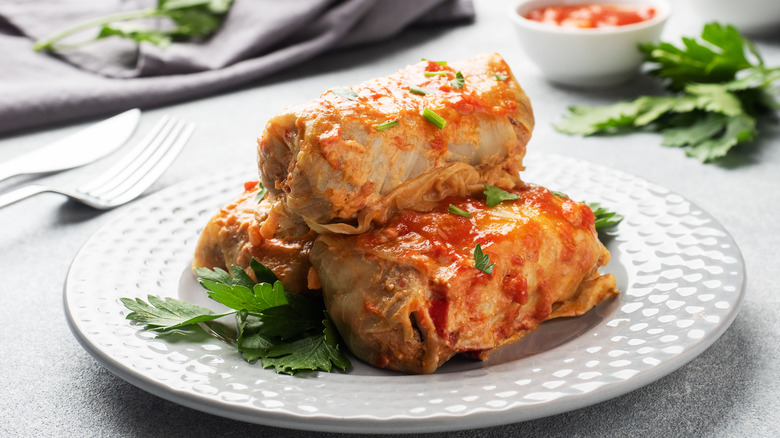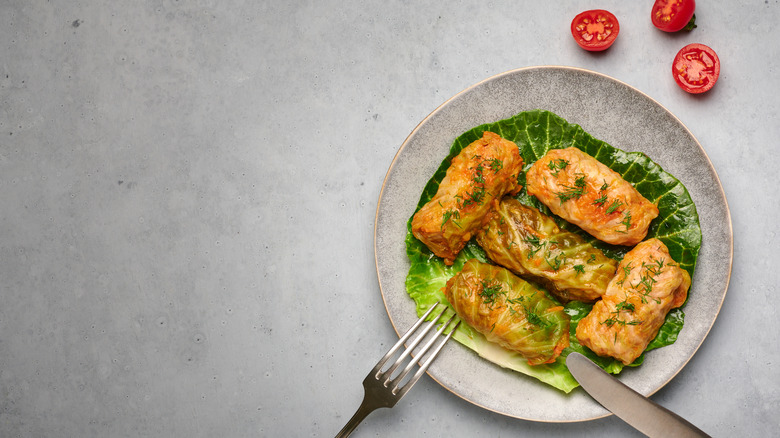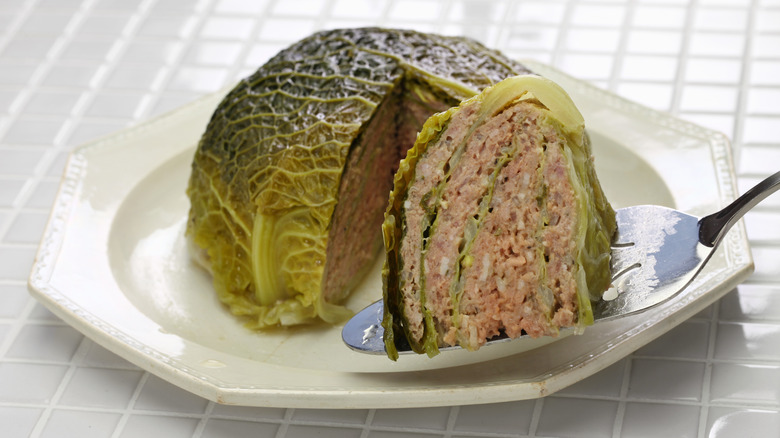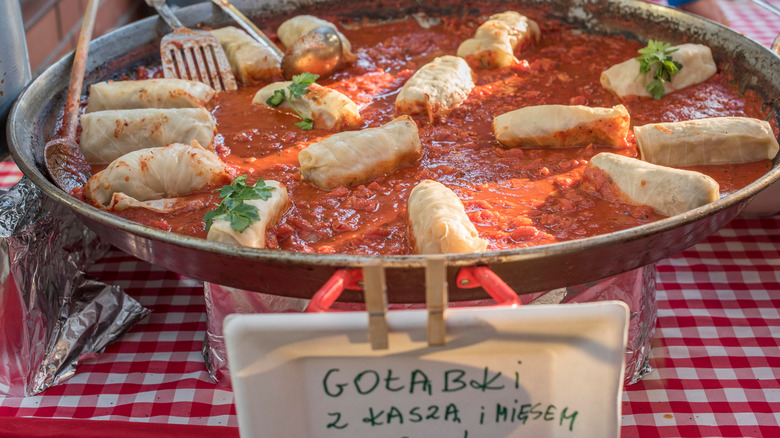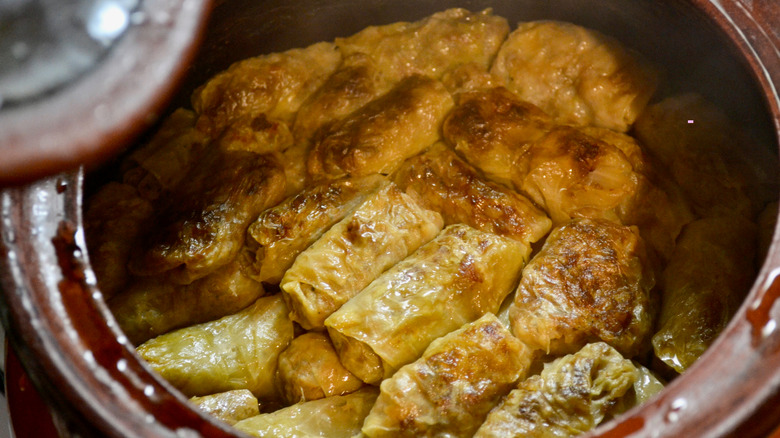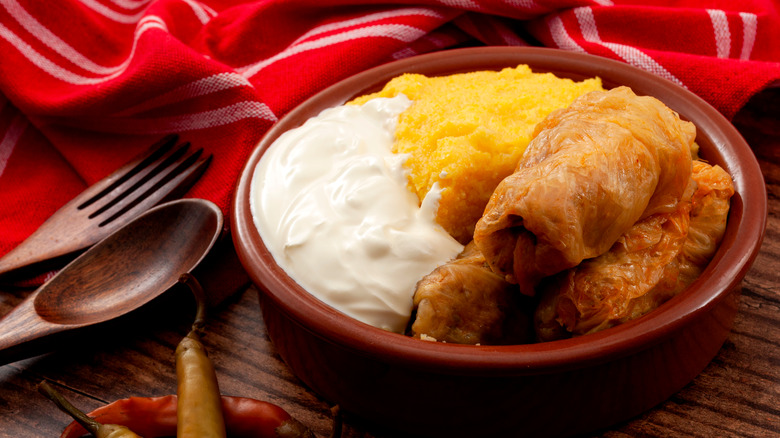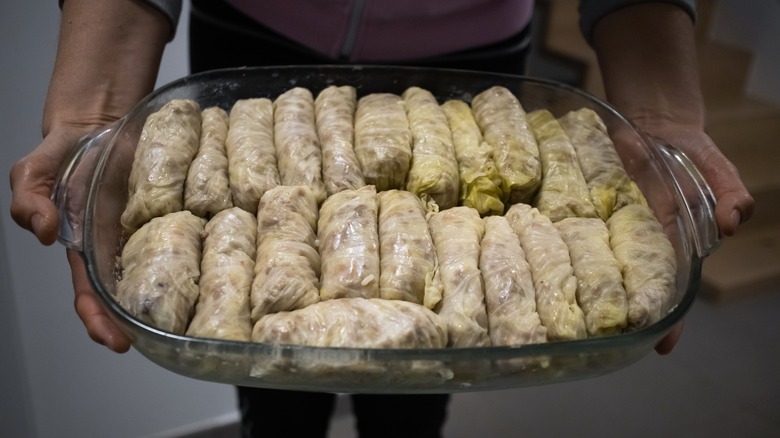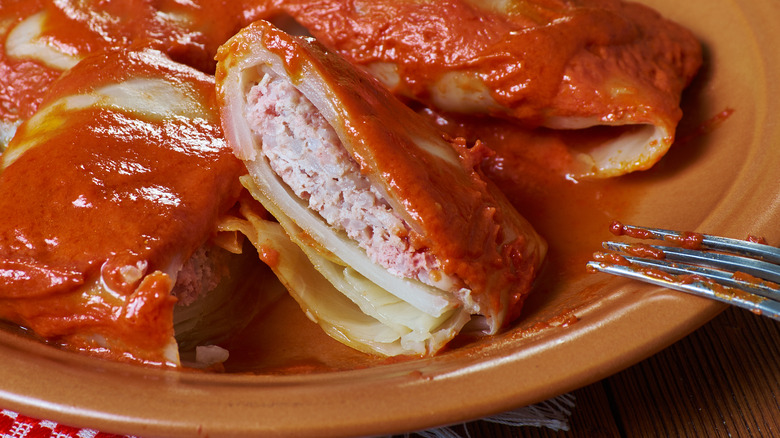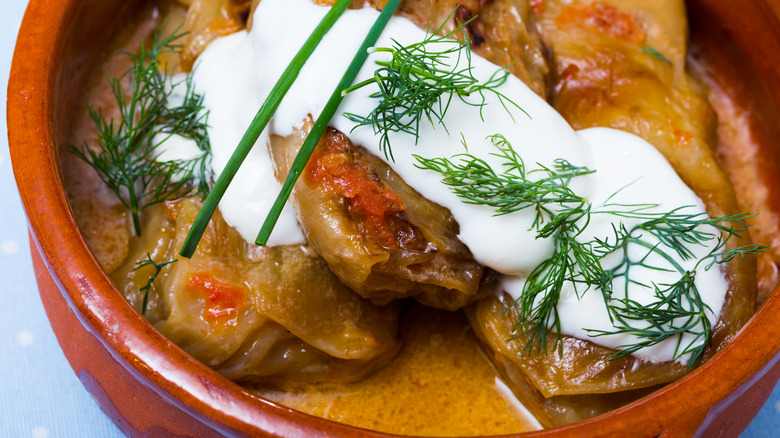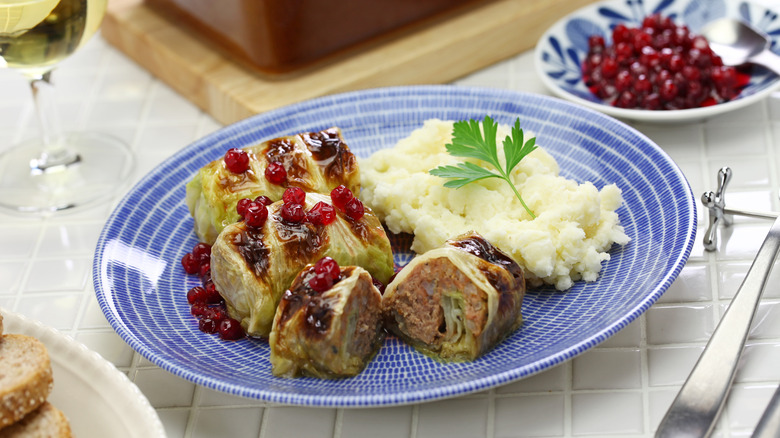9 Types Of European Cabbage Rolls, Explained
Cabbage rolls make for the perfect self-contained winter warmer, rice, meat, or vegetables wrapped up tightly in a cabbage leaf and then cooked to form the ideal edible parcel you don't even need to unwrap to enjoy. Much like other wrapped foods, including tamales or dumplings, cabbage rolls are an excellent way to use extra bits in your fridge to reduce waste, which is perhaps why the food first became popular.
Though they can still be enjoyed in the summer months across Europe and in parts of Scandinavia, cabbage rolls tend to be enjoyed in the winter months as part of festivals and celebrations, as well as everyday life. Their flavors, fillings, and cooking methods differ from region to region based on the availability of ingredients and spices.
According to La Jolla Light, variations of the cabbage roll have been a part of Jewish cooking for over 2,000 years, often made as a part of Simchat Torah; when the traditional weekly reading of the Torah reaches the end, the story begins once again.
Though debated, the origins of this dish may trace back to the Turkish (via Tried & True) before traveling across Eastern Europe and up into Scandinavia, changing forms along the way.
As the nights close in, we can think of no better reason to cook up a big pot of cabbage rolls. Here are a few different kinds to inspire you.
Holubtsi from Ukraine
According to many, including Poland Unraveled, traditional Ukrainian cooking includes making holubtsi, their version of stuffed cabbage. This dish first endeared itself to Ukrainians, adapted from an aristocratic dish that often used pigeons as filling. Other Eastern European countries then adapted the dish around the 19th century.
Now filled with a mix of pork and beef, the key ingredient that makes holubtsi definitively Ukrainian is the addition of barberries, which give the dish its signature sour flavor.
Barberries are bright red berries grown on thorny shrubs. According to MasterClass, there are four signature varieties, including European, Japanese, American, and Oregon grape, each with slightly different flavors. Barberries are not limited to Ukrainian food; they're used in various dishes throughout the Middle East, North Africa, and even parts of India. If you struggle to find barberries for your holubtsi, you can substitute them with ingredients like dried cranberries, sour cherries, or even raisins soaked in lemon juice to achieve that same sour note.
Ukrainian food writer Olia Hercules instructs readers of her cookbook, "Mamushka: A Cookbook, Recipes from Ukraine & Eastern Europe," to top their holubtsi with sour cream and dill and to serve with good sourdough bread for scooping up any remaining sauce or ingredients.
Sou fassum from France
This cabbage dish is known by several names, including chou farci à la Niçoise, sou fassum in Nice and lou fassum in Grasse, France. The dish, eaten in and around the South of France where the weather dictates lighter, more Mediterranean fare, doesn't get much of a looking in modern times, at least not compared to some of its cabbage-wrapped relatives here on this list. This might be due to its time-consuming preparations, though you shouldn't let them deter you.
According to Provence Holidays, the Provençal French version of stuffed cabbage includes meat, rice, and notably chard and stale, milk-soaked bread within its filling, which is then wrapped in cabbage leaves and braised in chicken stock. The dish came to France from another Mediterranean neighbor, adopted from the Greeks around the 5th century.
Rather than individually wrapped small parcels, sou fassum is often presented in one large dome, the filling encased in many blanched cabbage leaves and then served into slices, adding some drama to the presentation as well as a level of difficulty. The French never do anything in halves, do they?
Gołąbki from Poland
Gołąbki, according to the travel website Kayak, made its way into Poland sometime in the 19th century by way of Ukraine and decided it wanted to stay a while. Or rather, the people of Poland decided they were never letting the cabbage-wrapped parcels go. Today, many consider it a traditional food of the area, much loved by Polish residents.
The Polska Polish Tourism Organization postulates that the rolls, filled with ground meat, onion, rice, and mushrooms, are called gołąbki, meaning pigeon, because their shape resembles that of a pigeon or dove breast or because of the filling variation the dish once contained. Much like in Croatia, Polish cabbage rolls were first made with buckwheat groats rather than rice and served with sour cream and mushroom sauce. Today the variation has changed to incorporate rice and a rich tomato sauce instead. We think both sound delicious, filling, and warming!
The Culture Trip has also named the dish as one known to stoke feelings of homesickness from the Russian diaspora when they are far from home, which shows how many different countries can have overlapping tastes. They are a dish best eaten in the comfort of home. According to food critic Piotr Bikont, "they are typical homemade food. Many years of experience finally taught me not to order gołąbki at a restaurant" (via Culture.pl).
Sarmi from Bulgaria
You would be wise not to underestimate the cuisine of the small but mighty country of Bulgaria. According to Fine Dining Lovers, this little country located just south of Romania and north of Greece and Turkey has influenced many bordering countries and cuisines. Bulgarian cuisine is also an amalgamation of outside influences that create a unique expression of the country's history. Not to mention its location puts it in a prime spot for a wide variety of products, including cauliflower, turnips, zucchini, and cabbage (via Bulgarian Agriculture).
Bulgarian cuisine often involves quite a few pickled or brined vegetables and salty cheeses, which can work to balance out rich cured sausages, hearty moussaka, a variety of grilled meats, and sarmi, Bulgaria's take on cabbage rolls. The rolls can be made from either vine leaves, like the dolmas in neighboring Greece and Turkey, or from cabbage, as they are in Romania. Bulgarian sarmi are often filled with pork or veal, then wrapped in pickled cabbage leaves.
According to Radio Free Europe Radio Liberty, many Bulgarians will eat a vegan diet during the lead-up to Christmas, removing the meat from their cabbage rolls if serving or eating them during this time of year.
Sarmale from Romania
While other countries might consider themselves fans of cabbage rolls, according to Tried & True, Romanians take that love to a new level, incorporating what they call sarmale into the foundation of traditional Romanian cuisine. So much so that it is a sought-out dish for tourists and locals alike, which is why The Culture Trip has even created a guide to finding the best that money can buy when visiting the Romanian city of Bucharest.
Sarmale distinguishes itself from its cabbage roll relatives in several ways. Firstly, the cabbage leaves are pickled before encasing the meaty filling, which can incorporate veal, pork, or even rich goose or gamey wild boar. Rice is also incorporated into the filling, boiled until creamy, says The Culture Trip, but not to the point where the roll loses its pleasing shape, before being topped with the obligatory crème fraiche. Here the dish is sometimes served with polenta, a wonderful cross-cultural expression of the overlap of many traditions. Even National Geographic ranks a sarmale tasting as one of the top 10 activities in Romania's capital city.
Sarma from Croatia
According to Croatia Week, traditional Croatian sarma is a meat dish with a filling that includes a mixture of beef, pork, and rice. It is so ubiquitous that it is considered a national dish of Croatia and the Balkans, even though it didn't originate there. Sarma, meaning "wrapped" in Turkish, is also the name of the stuffed grape leaf rolls, created during the Ottoman Empire and well-known within Turkish cuisine, which is where the dish is thought to have originally been made (via Maza Mediterranean Grill and Lounge).
Croatian sarma's cabbage leaves are pickled before being used to wrap the filling, balancing the rich meaty filling and a slightly sour, vinegary, or salty flavor from the leaves. Croatia Week also notes that the filling has changed over time. Barley and buckwheat were originally the favored filling of choice as opposed to rice due to agriculture, the largest grain-related crops being wheat, corn, oats, and barley (via the Agricultural Sector of Trade.gov).
Sarma is often eaten alongside potatoes in various forms as a part of winter celebrations such as Christmas or New Year when large groups of friends or family gather to share a meal.
Balandeliai from Lithuania
Filled with ground meat and rice and boiled, fried, or baked in a light tomato sauce, then topped with sour cream, balandeliai are the well-loved Lithuanian iteration of the popular Eastern European cabbage roll. Lithuanians share this dish with various Jewish communities of Eastern Europe alongside the country's neighbors of Russia and Ukraine. The name alongside ingredients varies slightly as it travels between borders and communities.
Balandeliai, depending on who you ask, translates to mean "little pigeon" or "little dove." Much like with other similarly named rolls, there is debate as to the source of its name, referencing either the shape of the small but meaty parcels or the influence of roasted pigeon, a popular dish served within aristocratic French cuisine, that made its way across the continent, changing form to accommodate for local tastes and less extravagant budgets (via Russia Beyond).
According to The Walking Parrot, balandeliai are a must-try taste of Lithuania. They would be incredibly delicious when served alongside a few other traditional favorites like kugelis, Lithuania's national dish made from potatoes, bacon, and eggs, and topped with žemaitiškas kastinys, a rich hand-made sour cream made from milk, butter, and often flavored with herbs and spices. This combination sounds like the ultimate way to enjoy a comforting taste of Lithuania.
Golubtsy from Russia
The folks at The Culture Trip have called golubtsy one of the best savory snacks in Russia. Considering the heft of these meat-stuffed parcels, we think this says a lot about the grit of Russians and the seriousness in which they take their sustenance. It also says a lot about food and drink requirements to see Russian residents through a bitterly cold winter.
Golubtsy is a well-known Russian dish that many families will eat regularly, especially once the weather turns in the autumn and winter months. Intrepid Travel suggests that a traditional meal offered to guests within a Russian home might begin with a cold appetizer consisting of a variety of pickles, meats, smoked fish, and salads, known as zakuski, before moving onto hotter, heartier fare like golubtsy, accompanied, most likely, with freezer-cold vodka.
Like with the other cabbage wraps, it is a bit of a mystery whether this now traditional dish originated from the variations like lamb-filled dolmas from 13th-century Ottoman Empire or if it came later as a response to the roasted pigeon feasts, which were considered fashionable in France around the 19th century. According to Russia Beyond these meat-filled wraps may have first been stuffed simply with whole roasted pigeon before evolving into their current form.
Kåldolmens from Sweden
Northern European countries, like Sweden, are not exactly known for their warm, light-filled, balmy winters. Quite the opposite, which is why it's not surprising that the Swedes turn to winter warmers like kåldolmens — the Swedish version of cabbage rolls — at this time of year.
According to The Culture Trip, kåldolmens found their way north via King Karl XII, who took a shine to them after his time spent eating salma in the Ottoman Empire in the early 18th century. Interestingly, however, the Swedish interpretation, which presumably came about once King Karl returned home, uses cabbage leaves like the Croatian version, but only boiling rather than pickling them. The meat-filled cabbage rolls are topped with a thick gravy and lingon sauce, made from lingonberries, which, much like cranberries, are known for their tart flavor.
It's interesting to see similar flavor profiles achieved through different native ingredients, like the barberries in Ukrainian holubtsi, which works to achieve the same tart flavor as the lingonberry sauce does in the Swedish version.
According to Nordstjernan, each year since 2010, Sweden now celebrates its nationally recognized holiday known as Kåldolmens Day, honoring the history and heritage of their cabbage rolls.
